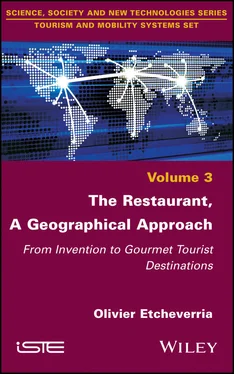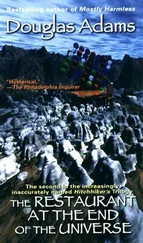Diners “were served individual portions of dishes that they chose from a framed sheet of paper, before resolving the ‘paying card’, i.e. the bill” [PIT 91, p. 159, author’s translation]. Thus, the menu was born, presenting the prices. Food was served on demand all day long. Wine was no longer used only to quench your thirst: it came to accompany dishes and allowed for food and wine pairings. Water could be served in bottles. The service remained attentive to the expectations and demands of diners.
Indeed, Rebecca L. Spang insists on the emergence of a new form of manners that gave primacy to the individual and to their needs, desires and pleasures:
“The restaurant gave new significance to the individual’s emotions, utterances, and actions, and elaborated a whole new logic of sociability and conviviality. While the serving of salutary dishes was the restaurant’s initial raison d’être , fans of the restaurant spoke with equal enthusiasm about the many other delights available there.” [SPA 00, pp. 66–67]
The restaurant therefore became a place of free choice where food intake was motivated, desired and individualized. According to Tristan Hordé, the restaurant appeared in a context in which the idea of the individual was affirmed: “the idea of the ‘individual’ was imposed, at least in the dominant urban social classes” [HOR 17, p. 12, author’s translation]. Then, the restaurateur responded to the expression of individual needs and desires related to taste; the taste preferences of the individual eater. Rebecca L. Spang points out that:
“Some twenty years after they were first established, restaurants no longer specialized in providing delicately healthful soups to a genteelly weak-chested clientele but in catering to individual tastes. While the traiteur fed large groups, the restaurateur offered single servings and small, intimate tables. […]. The restaurateur invited his guest to sit at his or her own table, to consult his or her own needs and desires, to concentrate on that most fleeting and difficult to universalize sense: taste.” [SPA 00, p. 75]
Therefore, the diner held an essential role: they made a real choice . They took on a “buyer” role. The birth of the restaurant thus marked the transition from a situation where the eater was an agent (human operator or agent capable of voluntary actions and their own initiatives but possessing no strategic competence: he/she was not a decision-maker and even less a designer) to one where he/she became an actor (agent with subjective interiority, intentionality, autonomous strategic capacity and an ability to express oneself) [LUS 03, p. 39]. The buyer (the diner) of this particular service, that of catering, was therefore at the initiative and design stage, insofar as there was a simultaneity of production and consumption. Thus, the diner became a “coproducer” of the catering service with the chef.
DEFINITION.– Services are: “in the broadest sense, all economically productive activities that do not include the manufacture of material objects. In a narrow sense, this whole, excluding exchange activities. Services are in fact an economic and spatial phenomenon quite apart in the production of wealth. Unlike material goods, services are only realized by consuming them: the usual production/consumption distinction does not work very well. The production of a service involves the combination of three elements: a material basis, a contact staff and a customer. There is therefore joint production by the customer and the company. The economist Jean Galdrey proposed the concept of ‘servuction’ to reflect this specificity. It follows that a service is not tangible and cannot be stored.” [STO 03, pp. 834–835, author’s translation]
How is the concentration of restaurants reflected? How did restaurants spread in Paris?
1 1Come to me, all of you whose stomachs are in distress, and I will restore you.
2 2Which roughly translates to “The General Almanac of Personal Address and Permanent Residence of Six Corps, Arts and Crafts”.
3 3Weekly sheets L’Avantcoureur of 1767, quoted by Patrick Ramboug [RAM 10, p. 190].
4 4In Paris à table, Eugène Briffault emphasizes: “Originally, the restaurateur was not allowed to put a tablecloth on these tables. They were covered with a green or jasper waxcloth” [BRI 03, p. 91, author’s translation].
2
The Concentration of Restaurants in the City Centers
Restaurants were born in urban areas and are particularly concentrated in the city centers.
DEFINITION.– The urban center is an “urban geotype characterized by the maximum association of the density and diversity of social realities […]. An urban center has a potential, linked to its level of urbanity (urbanity being considered as societal production, arranged in space, resulting from the interaction of density and diversity), and also to the modalities of the spatial disposition of density and diversity. This potential, which expresses the attractive and polarizing capacity of the center, is called centrality” [LUS 03, p. 144, author’s translation].
The center offers the specific coupling of density and diversity from a human, socioeconomic and cultural point of view. The centrality of restaurants corresponds to a strategic location that places the needs of the dense and diverse at the heart of the concerns of the first restaurateurs. The density and diversity of the permanent inhabitants ensure a potentially stable local customer “fund”. In addition, the density and diversity of temporary inhabitants (tourists) allow for additional customers. More generally, this centrality of restaurants is expressed in the density and diversity of flows, relationships and exchanges, products, capital, information, discourses and imaginations.
The first restaurants were established and developed in the center of Paris, particularly at the Palais-Royal.
While the restaurant requires density and diversity, it was initially so, as shown by the solid and liquid contents of the menus of the first restaurants. The menu of the restaurant Véry is exemplary (see Figure 2.1). Pierre Andrieu recalls the geographies of this restaurant:
“At the beginning of the First Empire, a Lorraine native named Véry opened a restaurant in Les Tuileries, on the terrace of Les Feuillants, and then, in 1808, opened a branch near the Palais-Royal theater, and its reputation was soon to eclipse the first house […]. Véry’s name alone evokes a Palais-Royal sparkling with life and luxury, galleries cluttered with beautiful figures with bare arms, shoulders open to the air, while passing by them, dragging their Essling or Jena swords, the dashing officers, Oudinot’s grenadiers or Murat’s horsemen.” [AND 55, pp. 38–39, author’s translation]
In a context of concentration, restaurants, places of density and diversity, were intersected by flows and animated by centripetal forces. Through the service offerings, practices, discourses and imaginations they instilled, restaurants also produced density and diversity, and thus reinforced them. It was a dynamic of polarization.
2.1. A center-specific logic…
Since their invention, restaurants have found privileged locations in the city center, which is a geographical context of concentration (accumulation of a large number of social realities in a limited area) of people and socioeconomic and cultural activities, and therefore of potential customers. And products too.
DEFINITION.– “In the narrow sense, [centrality is] the central position of a place or area in a space. By extension, the ability to polarize space and make a place or area attractive, which concentrates actors, functions and objects of societies […]. In geography, the centrality of a place only really makes sense when we associate its position in physical space with the measurement of the radiation of potentials and functions located in that same place and when we consider the gradients and ‘fields’ that they produce and have in space. Walter Christaller constructs his model of central places based on an examination of the relationship between commercial and service functions and the physical distance between settlement points. According to this model, a balance between demand, and supply of goods and services is spontaneously organized in the regional space, which minimizes consumers’ travel costs. This is why supply functions are concentrated in the most accessible, so-called central places: those where demand reaches the levels necessary for supply to be profitable.” [DEM 03, pp. 139–140, author’s translation]
Читать дальше












